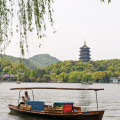WEST LAKE
Xihu, Western lake, is the main attraction of Hangzhou. He has been a UNESCO World Heritage Site since 2011. For the Chinese, it is nothing less than one of the wonders of the country! Therefore, it appears on the bank notes of 1 RMB (back). Approximately 15 km of circumference, with an average depth of 2,27 metres, the lake has a capacity of 14 290 000 m 3 water. It is surrounded by sumptuous hills and, to the east, by the city centre. Hangzhou Western Lake is ubiquitous in Chinese literature and history. For example, a poet from the Yuan dynasty invented the very famous saying: " Heaven, on earth, there is Suzhou and Hangzhou ". Or, an old Chinese proverb tells us that it's supposed to be born in Suzhou, eat in Guangzhou (Canton), live in Hangzhou and die in Liuzhou. Finally, we cannot talk about Xihu and Hangzhou without quoting Marco Polo, who went there at the end of the th century during his trip to China, and describes the city and its atmosphere as being «the noblest of cities, the city of paradise».
The Western Lake is an extremely pleasant place to recharge away from the stress of Hangzhou. It occupies an area of 5,6 km ². It is difficult to turn around, but you can easily rent a boat (on Nanshan Lu -南山路) to explore the site and immerse itself with the serenity of the place.
All around the lake and even in the centre of the lake, there are many points of interest. All are in free access and sound as a constant reminder of traditional Chinese culture. They are to discover by all the time, by great sun (attention still in summer, it can quickly do very hot on the edge of the lake) as in rain time: the decor is then almost magical.
In the heart of the lake, the main island, Gushan or «île de la Montagne solitaire» is connected to the city centre by a suite of two ancient bridges between which the flag of the snow melting on broken bridge (Duanqiao Canxue - 断桥残雪) rises. It is named after the famous Chinese legend of the white snake. The snake, having met a young man, was transformed into a woman to marry her.
The fall moon pavilion above the quiet Lake (Pinghu Qiuyue - 平湖秋月), at the foot of the second bridge, offers a beautiful overview.
The island of the lonely mountain brings together the provincial museum (Sheng Bowuguan - 省博物馆), tracing the great periods of Chinese history, and Zhongshan Park (Zhongshan Gongyuan - 中山公园) where the Crane pavilion (Fangheting -) rises. He was the former residence of the famous poet poet, Ling Hejin, who was a hermit, cultivating his plum and collecting cranes.
On the other side of the island, the Société des graveurs de seal (Xilin Yinshe) is housed in an ancient building flanked by the stupa Du. Right in front of the Louwailou restaurant is the pier from which shuttle buses to the Moon island (Santan Yinyue - 三潭印月) are located. It was christened according to the three small stupa placed on the surface of the lake. Su Dongpo, governor of Hangzhou from 1071 to 1089, would have placed them in the deepest place after having dredging the lake to avoid lotus planting, large vase producers. Tradition dictates that these stupa be illuminated during the mid-autumn celebration when the moon is full.
Did you know? This review was written by our professional authors.
Book the Best Activities with Get Your Guide
Members' reviews on WEST LAKE
The ratings and reviews below reflect the subjective opinions of members and not the opinion of The Little Witty.
A noter un véhicule électrique fait le tour,
Beaucoup de monde le WE.
Les chinois se retrouvent autour du lac, pour danser et chanter ou faire du Taïchi.
à la mi-mars, les saules pleureurs retrouvent leurs feuilles et les fleurs éclosent un peu partout.
Les mariés affluent pour des photos mémorables.




Si vous recherchez le célèbre pavillon symbole du lac, il est au nord-est du lac. Les "tourelles" au verso des billets de 1¥ se trouvent sur une ile au milieu du lac. C'est endroit est très touristique